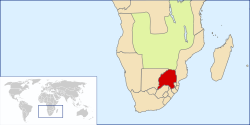Republic of Transvaal
| South African Republic | ||||||||||||
| Zuid-Afrikaansche Republiek (Dutch) | ||||||||||||
|
||||||||||||
|
|
||||||||||||
|
Anthem Transvaalse Volkslied |
||||||||||||
|
Location of the South African Republic, circa 1890
|
||||||||||||
| Capital |
Pretoria 25°43′S 28°14′E / 25.717°S 28.233°E |
|||||||||||
| Languages | Dutch, Afrikaans, Northern Sotho, Tswana, Ndebele, Tsonga, Venda, Zulu | |||||||||||
| Religion | Dutch Reformed Church | |||||||||||
| Government | Republic | |||||||||||
| President | ||||||||||||
| • | 1857–1863 | Marthinus Wessel Pretorius1 | ||||||||||
| • | 1883–1902 | Paul Kruger | ||||||||||
| • | 1900–1902 | Schalk Willem Burger (acting) | ||||||||||
| Legislature | Volksraad | |||||||||||
| History | ||||||||||||
| • | Sand River Convention | 17 January 1852 | ||||||||||
| • | British annexation | 12 April 1877 | ||||||||||
| • | First Boer War | 20 December 1880 | ||||||||||
| • | Pretoria Convention | 3 August 1881 | ||||||||||
| • | London Convention | 27 February 1884 | ||||||||||
| • | Second Boer War | 11 October 1899 | ||||||||||
| • | Treaty of Vereeniging | 31 May 1902 | ||||||||||
| Area | ||||||||||||
| • | 1870 | 191,789 km2 (74,050 sq mi) | ||||||||||
| Population | ||||||||||||
| • | 1870 est. | 120,000 | ||||||||||
| Density | 1/km2 (2/sq mi) | |||||||||||
| Currency |
Zuid-Afrikaanse pond (South African pound) |
|||||||||||
|
||||||||||||
| Today part of |
|
|||||||||||
| 1Also State President of the Orange Free State | ||||||||||||
The South African Republic (Dutch: Zuid-Afrikaansche Republiek, ZAR), often referred to as the Transvaal and sometimes as the Republic of Transvaal, was an independent and internationally recognised country in Southern Africa from 1852 to 1902. The country defeated the British in what is often referred to as the First Boer War and remained independent until the end of the Second Boer War on 31 May 1902, when it was forced to surrender to the British. The territory of the ZAR became known after this war as the Transvaal Colony.
After the outbreak of the First World War a small number of Boers staged the Maritz Rebellion by declaring the reinstatement of the South African Republic and aligned themselves with the Central Powers. The rebellion was put down by British forces in February 1915.
The land area that was once the ZAR now comprises all or most of the provinces of Gauteng, Limpopo, Mpumalanga, and North West in the northeastern portion of the modern Republic of South Africa.
Constitutionally the name of the country was Zuid-Afrikaansche Republiek (South African Republic or ZAR). Many people also called the ZAR Transvaal, in reference to the area over (or trans) the Vaal River, including the British press and the press in Europe. In fact the name "Transvaal" was later so often used that later the British objected to the use of the real name (The South African Republic). The British pointed out that the Pretoria Convention of 3 August 1881 referred to the 'Transvaal Territory' and that the Transvaal and the South African Republic did not have the same boundaries. However, in the London Convention dated 27 February 1884, a subsequent treaty between Britain and the ZAR, Britain acquiesced and reverted to the use of the true name, "The South African Republic".
...
Wikipedia



